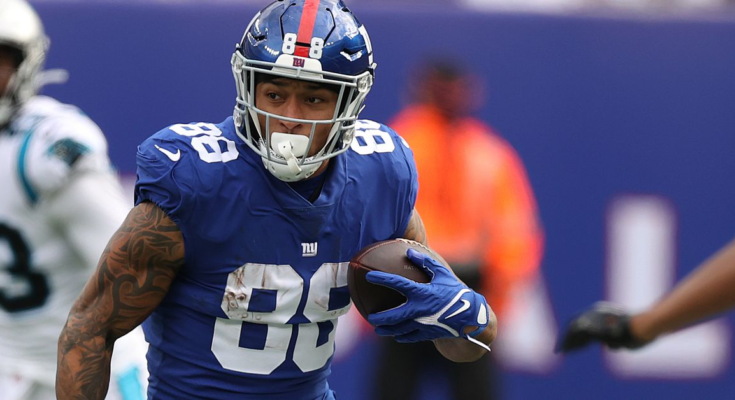The New York Giants secured their second win of the season on Sunday, beating the Carolina Panthers 25-3.
The score was much closer for most of the game than the 22-point margin of victory would suggest. The game was a tight 5-3 affair until the 44-minute mark, at which point the Giants scored 20 points in the final 16 minutes of the game.
The Giants don’t have long to revel in their win, as they have to turn their attention to Monday Night Football and the Kansas City Chiefs. But before we close the book on Week 7, let’s take a look at what the numbers have to say.
Snap counts
Offense
:no_upscale()/cdn.vox-cdn.com/uploads/chorus_asset/file/22953671/Screen_Shot_2021_10_25_at_8.46.27_AM.png)
The Giants once again started the game in their 12 personnel package, with Evan Engram, Kyle Rudolph, Darius Slayton, and John Ross on the field. From there they split their time fairly evenly between 12 and 11-personnel packages.
Perhaps the most interesting part of the Giants’ offensive snap counts is just how many snaps all of their receivers got. Even Collin Johnson played over a quarter of the snaps, while David Sills V played nearly 40 percent of his first NFL game.
We’ll see in a bit why it was also a bit of a weird move.
Defense
:no_upscale()/cdn.vox-cdn.com/uploads/chorus_asset/file/22953679/Screen_Shot_2021_10_25_at_8.49.54_AM.png)
The Giants clearly took Matt Rhule’s promise to lean into the running game seriously. They took the rare step of starting the game in their base defense and played nearly two-thirds of the game with three defensive linemenon the field.
The Giants did rotate players, with linebackers Reggie Ragland and Lorenzo Carter, as well as S Jabrill Peppers and CB Darnay Holmes all playing nearly half the defensive snaps. Quincy Roche (who I still can’t believe the Steelers waived) played more than a third of the defensive snaps and flashed repeatedly when he was on the field.
Stats and analytics
Before I get to the Giants’ offensive snaps, I need to go back to last night when I called out Sam Darnold as not being a starting caliber NFL quarterback. With the tracking data and advanced analytics in hand, I can put in context just how bad his performance was.
Starting with the raw numbers from NFL NextGenStats.
Darnold’s intended air yardage was a paltry 4.6 yards downfield, second-lowest on the weekend behind Jared Goff. However his average completion was an amazingly low 1.7 air yards, or just a little over 5 feet downfield. That’s compounded by a time to throw of 2.84 seconds, which was the 8th longest. And while Darnold did manage to complete 64 percent of his passes, that was still 7.1 points below his expected completion of 71.1 percent.
In terms of EPA, Darnold garnered a -11.4 (-0.39 per play). That put him in the 10th percentile of all quarterbacks since 2010 (7th percentile in per play EPA).
What does that look like on the field? Here’s his passing chart:
:no_upscale()/cdn.vox-cdn.com/uploads/chorus_asset/file/22953715/Screen_Shot_2021_10_25_at_9.14.21_AM.png)
https://rbsdm.com/stats/box_scores/
The problem for the Giants, and why this game just doesn’t feel like a “win” to me, is that their own offense was just kinda there until the Panthers’ frustrations finally broke them.
Daniel Jones played better than Darnold and didn’t actively hurt the Giants, but he still didn’t play particularly well.
The Giants clearly schemed as many quick passes as they possibly could to take pressure off of their offensive line. That translated to an intended air yards of 6.2 and an average completion of just 3.6 air yards. That has Jones nestled between the likes of Jared Goff, Case Keenum, Davis Mills, and Teddy Bridgewater.
Jones had a -2.8 EPA and a -0.06 EPA per play on the game (32nd and 30th percentiles, respectively).
Of Jones’ 33 pass attempts, 24 came less than 10 yards downfield, and most of those came less than 5 yards downfield.
:no_upscale()/cdn.vox-cdn.com/uploads/chorus_asset/file/22953730/Screen_Shot_2021_10_25_at_9.22.07_AM.png)
And despite the Giants’ shallow passing attack, Jones still held the ball an average of 2.62 seconds — though that was likely a result of the Giants’ reliance on play-action, RPO, roll-outs to both help the Giants’ pass protection as well as cut down the field for Jones.
This is why it was a bit odd that the Giants used so many receivers. They were either unable or unwilling to push the ball down the field, and their play designs were crafted to cut the field in half. It isn’t necessarily a bad thing that the Giants got a variety of players involved — usually it’s quite the opposite — but it stands out as odd to have eight different receivers doing basically the same thing.
Both teams also clearly wanted to run the ball coming into the game, but neither team did it well.
Chuba Hubbard 28 yards on 12 carries (2.3 per carry), while Royce Freeman got 18 yards on 3 carries (6.0 per carry), before the Panthers were forced to abandon the run completely.
Devontae Booker picked up 51 yards on 14 carries (3.6 per carry) while Elijhaa Penny got 25 yards on 9 runs (2.7 per carry).
Based on those stats, it would be fare to assume that the opposing defenses were stacking the box and clamping down on the run. However, that was definitely not the case.
The Panthers only played eight-man boxes on two of Booker’s runs, while the Giants stacked the box on three of Hubbard’s runs.
*Note: NextGenStats capped the minimum carries at 10, so Penny and Freeman aren’t listed
Pro Football Focus grades
:no_upscale()/cdn.vox-cdn.com/uploads/chorus_asset/file/22953853/Screen_Shot_2021_10_25_at_10.22.53_AM.png)
:no_upscale()/cdn.vox-cdn.com/uploads/chorus_asset/file/22953854/Screen_Shot_2021_10_25_at_10.23.21_AM.png)


